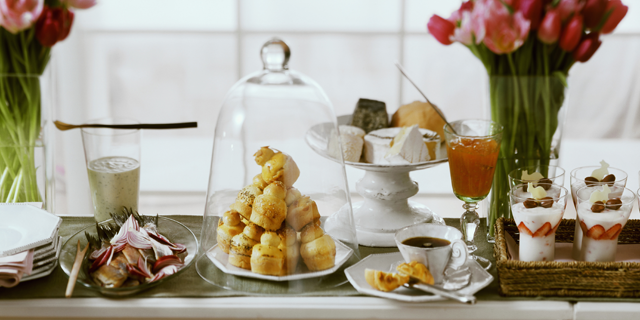Brunch is brunch is brunch. Once special and rare, brunch is thought to have descended from the after-hunt meals enjoyed by British nobility. It was popularized by American hotels in the 1930s and served to the cognoscenti who could afford to imbibe on Saturday night and sleep through church on Sunday morning. But with prevalence, inevitably, comes predictability. Today, this cocktail-fueled buffet has become as familiar as, well, breakfast and lunch. So how to make brunch special again?
Easy: Put some elegant Basque flavor in the brunch business. Not only did the Basque, stemming from coastal northern Spain, also love to hunt (and likely had similar spreads afterwards), they created the renowned dish of baked eggs that’s so good even Alain Ducasse has a version.
They’re masters of the movable feast, otherwise known as pinxtos, which you eat little by little in a number of different locations throughout the day or night. They also happen to be a warmly welcoming people, as if they invented hospitality. Plug these ingredients into an equation, and the sum could easily be a Basque-inspired holiday brunch that stands out from all other mid-day meals served in any other country.
“A holiday brunch is a chance to get away from the ordinary, and create something [that] becomes talked about,” says Havana-born and Basque-raised Alejandro Muguerza, founder and co-owner of Le Basque Catering and Productions in Miami. “They are occasions that require special care. [Brunch is] an opportunity to dust off and bring out your most treasured serving pieces, a set of china you found at the back of an antique store, beautiful linens that never seem to get used, or a favorite set of glassware. As daunting as the effort may seem, don’t hold back. In fact, go completely all out.”
To that end, Muguerza also recommends forging centerpieces from “highly polished silver and glass containers” as well as picture frames, decorative boxes, books, sculptures and even lamps – in short, any objects that represent you. Mix in neutral flowers and seasonal fruit for a look that resembles a still life such as an Old Master might have painted. “These details reflect your personality and will go a long way to create an atmosphere that welcomes your guests warmly to your home.”
Next, what to serve at your Basque-style brunch…
[pagebreak]Certainly, such an ornate set-up recalls Old World Europe with its sterling charm and formal manners. That’s why the fare that Muguerza and well-known Basque chefs Aitor Elizegui (from Bascook Restaurant in Bilbao) and Aitor Basabe (from Arbolagaña Restaurant at the Museum of Fine Arts in Bilbao) recommend serving seems so counterintuitive. But contemporary Basque hosts would rather dress the table than dress up natural, quality ingredients.
Moreover, they believe it wiser to spend time relaxing over food with family and friends than in the kitchen cooking it. So rather than contriving elaborate dishes with complicated steps – “New Basque Cuisine” relies heavily on reinvented alta cocina methodology – they advise offering seafare and traditional pintxos that are easy to prepare.
For instance, Elizegui likes a talo-txistorra croqueta, which is a take on the traditional béchamel-based croqueta. Talo was used as bread in Basque houses (originally in Gipuzkoa) and the leftovers were mixed with milk, making something similar to soup, which was then eaten for dinner. In the 20th century, the commercialization of wheat bread reduced the consumption of talo, which became a special occasion bite.
The dough has to be formed 24 hours in advance. But once that’s done, it’s a quick process to actually form and fry the croquetas, cutting down on extensive day-of preparation. “When you fry the talo croqueta, don’t be afraid to use olive oil at high temperatures,” Elizegui says. “Remember that its all pre cooked, [so] all you need is to do is brown the croquetas.
Other options relying on high-heat cooking include Basabe’s octopus. “Octopus is not that hard to prepare,” he notes. “The secret is to cook it at high heat, covered tightly, so that it can release its own juices. [It] is a typical weekend brunch dish we eat in the Basque Country at home.”
Indeed, Muguerza says: “For very special occasions, we look to the riches of the ocean’s bounty. What is more celebratory than succulent lobster, fresh-shucked oysters, delicate sea urchin roe, and delicious giant prawns? We can leave the lengthy and fastidious preparations of the sauces and roasts for the night, and for the morning delight in simple, fresh, glorious seafood.”
Hear, hear. Or make that here, here, for his supple, yet simple, cod loin partnered with confit tomatoes and artichokes. Sure, it really should be served on your great-grandmother’s Rosenthal placed precisely atop classic Basque linens. The point is, if you invest in the prep, you can also enjoy it, apron off, with your guests.
Next, three Basque recipes to get your brunch started…
[pagebreak]- 4 pounds octopus, cut into 1 1/2–2-inch pieces
- 1/4 cup extra virgin olive oil
- 1 large onion, quartered
- 1 head elephant garlic, cloves separated and peeled
- 1 stalk lemongrass
- 2 medium thin-skinned potatoes
- 1 medium parsnip
- 2 strips bacon
- 1/4 cup arbequina olive oil
- 1 handful panko breadcrumbs, toasted
- 6 ounces txistorra sausages, diced
- 1 quart vegetable broth
- 7 ounces corn flour
- 6 ounces olive oil, plus extra for frying
- 2 large eggs
- cornbread crumbs
- kosher salt and freshly ground black pepper
Roasted Black Cod with Tomato and Artichoke Confit
- 1 tablespoon cultured butter, melted
- 1 tablespoon clarified butter
- 15 artichoke bottoms or hearts
- 2 to 3 drops fresh lemon juice
- 20 cherry tomatoes
- 1 bunch fresh thyme
- 4 6-ounce thick cut pieces black cod loin
- dried chili threads
- kosher salt and freshly ground black pepper





![Making Mealtime Matter with La Familia: Easy Sofrito [Video]](https://thelatinkitchen.com/wp-content/uploads/2015/10/sofrito-shutterstock__0-500x383.jpg)
![Easy Latin Smoothies: Goji Berry Smoothie [Video]](https://thelatinkitchen.com/wp-content/uploads/2015/12/goji_berry-shutterstock_-500x383.jpg)
















![Fun and Fast Recipes: Fiesta Cabbage Salad [Video]](https://thelatinkitchen.com/wp-content/uploads/2015/11/fiesta_cabbage_slaw-shutterstock_-500x383.jpg)









